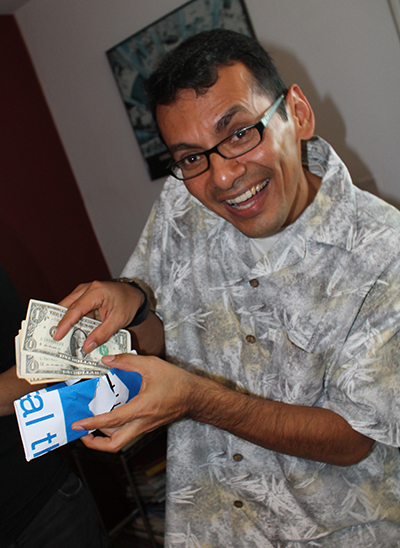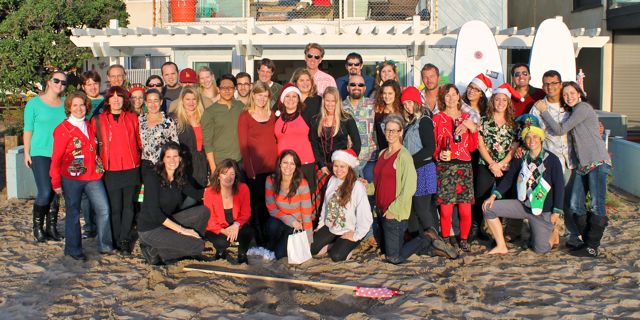The landlord, the man in the gray suit, jaws, white pointer, tommy shark, great white – whatever you call it, the elusive white shark has long been the subject of lore and legend. I know it’s a given for a marine biologist, but I have always been fascinated by white sharks. I’m now actively working with ocean groups up and down the coast on an organized campaign to create stronger state and federal protections for these awe-inspiring and misunderstood animals.
Throughout my studies and career, I’ve heard stories of SCUBA divers on Catalina startled by the shadow of a white shark passing in the waters above, seen shots of surf photographers unintentionally capturing an image of them breaching while focusing on their main subject – surfers – and fishermen encountering them while they are days offshore and far from civilization.
Since my college days, I told myself that I wanted to log enough ocean time to see a white shark in its natural environment, without luring it in or going to a spot with a high chance of an encounter. After living on a boat in Baja, spending years on the water teaching hands-on marine science on Catalina, and loads of time sailing, surfing, and diving in Southern and Central California, my moment finally came on a chilly September morning last year.
Seth Lawrence, an aquarist at the Santa Monica Pier Aquarium at the time, and I had taken his dinghy out in pursuit of the blue whales that were hanging out off the coast of Redondo Beach. It was an early, gray morning and the water was pure glass. After an hour of unsuccessfully searching for blue whales, we started to head into shore, and I saw a small fin at the surface in the distance.
I thought it was a Mola mola (ocean sunfish), pointed it out to Seth, and we cruised in the fish’s direction. As we got closer, we saw a second fin, and the animal was moving in an s-pattern characteristic of a shark. We were both excited, and drifting along, the animal soon became clear. It was a small white shark – about 3 ½ or 4 feet long – directly off the bow. I could have reached out and touched it!
We cruised along slowly behind it for a few minutes before it decided to dive to deeper waters. I was so excited to have my big fish story (and a shaky iPhone video to go along with it, complete with sounds of Seth and me in the background screaming with excitement). I consider myself lucky, as this is quite a rare occurrence, especially since we weren’t fishing or intentionally trying to see the landlord in a hot spot like the Farallon Islands or Guadalupe Island.
Staff scientists at Heal the Bay often get the question whether the recent uptick in anglers catching white sharks off the Manhattan Beach Pier, or seemingly more sightings along Santa Monica Bay beaches, means that white shark populations are rebounding. It seems like a simple question, but it’s often said that scientists know more about space than they do about the sea. Tracking fish is a complicated research proposition. It’s much easier to monitor animals on land with distinct geographic boundaries and habitats defined by buildings, roads and the like. It’s really tough to get a baseline assessment of just how many fish are out there, especially with transitory creatures like the white shark.
We know that there is a Northeastern Pacific population of white sharks that ranges from Mexico to the Bering Sea, and offshore to Hawaii, with aggregation sites off Central California, Guadalupe Island in Mexico, and a feeding grounds between California and Hawaii referred to as “the white shark café.” But, there is no historic population estimate for this region.
The first population assessments of white sharks in the Northeastern Pacific were only released in the past few years. These new studies show that the population is genetically distinct from other white shark populations around the world, and the numbers are astoundingly low. Photo identification and tagging studies from researchers at SCRIPPS, Stanford, and other institutions estimate that there are approximately 339 sub-adult and adult white sharks in the Northeastern Pacific. Compared to other apex predators in the ocean, these numbers are quite small. And, with no reliable metrics to compare changes in population over time, it’s tough to say whether white sharks in California are on the rise or decline.
So, should we be concerned? About a white shark attack in the water, probably not. (But it’s prudent to be careful in the ocean, as it’s a powerful and mysterious world). About their numbers in California waters, I think so.
As a surfer, I have had the feeling that something more powerful than me is lurking beneath the surface with its sights on me during a dawn or dusk surf session. White sharks are a top dog in the ocean, and deserve a healthy respect. Although they have to watch out, too – orcas (yes, the cute likes of Shamu) have snacked on white sharks at the Farallon Islands off the coast of San Francisco. But, the chances of a white shark attack on humans are extremely small, especially in the Santa Monica Bay, where most white sharks are pups and juveniles, which dine on fish, rays, and small sharks. There have been less than 15 documented fatal white shark attacks in California.
Although it is illegal to fish for white sharks in the U.S., they still face threats in their Northeastern Pacific range, including incidental catch from fishing vessels off the coast of California and Mexico, pollution, contamination, coastal development, and climate change. Recent research shows that white sharks are among the most heavily contaminated shark species. Mercury, PCBs, and DDT levels in juvenile white sharks were found to be six times higher than thresholds known to cause physiological and reproductive harm in other fish. As an apex predator, sharks play a key role in regulating prey populations and maintaining a balanced, healthy ocean ecosystem. It is important that shark populations remain viable for a healthy ocean environment.
In August, Oceana, Shark Stewards, and Conservation for Biological Diversity petitioned to list the white shark as threatened or endangered under the California and federal Endangered Species Acts. This designation would allow for the establishment of critical habitat for the Northeastern Pacific population of white sharks and the implementation of management measures to help protect white sharks from threats within their range. Sign our petition today to support the listing of the Northeastern Pacific population of white sharks as endangered or threatened under the California Endangered Species Act.
The shark research community has just started to scratch the surface of understanding their behavior and population trends. But, given that the white shark population is much smaller than other large marine predators, conservation actions are imperative to maintain a healthy ocean and continue to inspire generations with the natural wonder of sharks. They need to continue to be living and breathing kings of the sea, not just remembered in storybooks and scary movies.
–Sarah Sikich
Heal the Bay Coastal Resources Director

Learn more about what you can do to protect the white shark population in California and sign the petition.
Stay tuned on how you can help by following us on Twitter.
Visit our Aquarium at 3:30 p.m. on Shark Sundays to discover more about the misunderstood animals.




